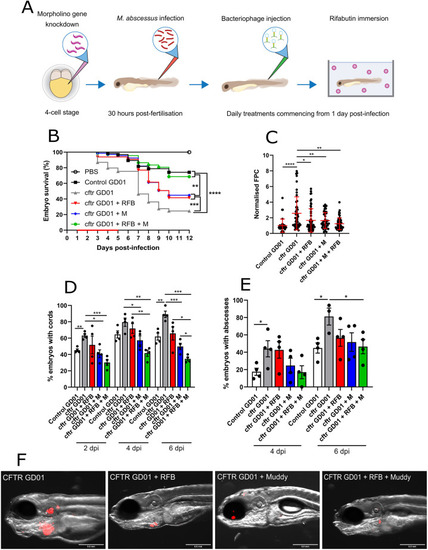
Activity of Muddy and rifabutin in GD01-infected cftr morphants. At the one- to four-cell stage, fertilised zebrafish eggs were injected in the nucleus with either control morpholino (control) or cftr morpholino via caudal vein injection. At 1 dpi, embryos commenced phage Muddy (M) and/or rifabutin (RFB) therapy through caudal vein injection at an MOI of 50:1 (phage:bacteria) based on initial bacterial infection inoculum. Embryos were treated daily from 1 dpi, up to and including 5 dpi with Muddy. RFB was added to zebrafish water daily at a final concentration of 50 µg/ml. (A) A generalised schematic showing the experimental design corresponding to the figure. (B) Embryo survival was monitored over a 12 day period, with embryos counted daily. Survival curves were analysed using the log-rank (Mantel–Cox) statistical test. The red bar across the x-axis indicates the duration of daily phage and RFB administration in the current experiment. (C) Bacterial burden (FPC) was analysed at 6 dpi using fluorescent microscopy. Fluorescent images were analysed in ImageJ using the ‘Analyze particles’ function. Bacterial burden was analysed using a Kruskal–Wallis one-way ANOVA. (D,E) The proportion of embryos with cords (D) and abscesses (E) was enumerated at 2, 4 and 6 dpi using fluorescent microscopy. Abscess and cord quantification was analysed using a Kruskal–Wallis one-way ANOVA. Data shown are the mean of three independent experiments±s.d. (n=20-30 per group for each experiment). (F) Representative cftr morphant images of embryos left untreated (GD01), treated with Muddy alone, RFB alone or with Muddy plus RFB at 6 dpi, showing the presence of extracellular bacterial cords or localised infection. Red overlay represents GD01 expressing TdTomato. *P<0.05; **P<0.01; ***P<0.001; ****P<0.0001.
|